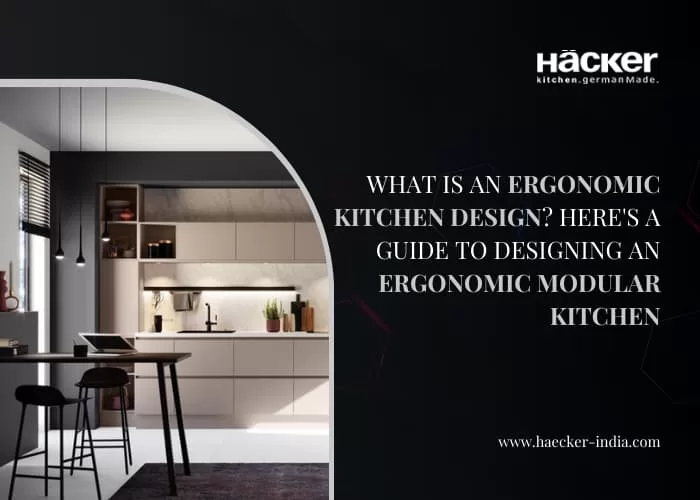Ergonomic kitchen design refers to a kitchen design that is efficient, comfortable, and accessible. An ergonomic kitchen design makes the kitchen a convenient and highly productive place. An ergonomic kitchen is an ideal kitchen that maximizes functionality.
If you intend to build a modular kitchen or want to do so soon, you must understand how to construct an ergonomic kitchen design to improve the kitchen operations.
Here’s a guide that explains how to create an ergonomic modular kitchen design. Read on to explore.
Tips to create an ergonomic modular kitchen design:
Boost workflow with a triangle:
In many of our earlier blogs, we have mentioned the significance of the kitchen ‘work triangle’ and why it should be implemented in the kitchen. The cooking, cleaning, and storage sections are the most important sections of the luxury kitchen design; in an ergonomic kitchen design, the cooktop, the sink, and the refrigerator should be connected by an invisible triangle.
Their strategic positioning would facilitate accessibility to these points as you work in the kitchen. However, always remember that the placement of the triangle will vary depending on the layout you select.
Systematic storage:
Since you store many cooking essentials in the kitchen, you must create adequate storage space for these essentials. As per kitchen ergonomics, you must create a storage zone in the kitchen that helps you maximize the space available and enhances accessibility. The pullout drawers are an excellent option for any luxury kitchen.
These drawers offer adequate storage space in the kitchen, and they also come with dividers and organizers; these organizers enhance accessibility. You can pull out a drawer, locate any item and access it in a jiffy. If you are storing myriad items in the drawer, you can keep everything sorted and organized. An ergonomic modular kitchen design is clutter-free.
Customization:
It cannot be stressed enough that a customized kitchen is essential to ensure functionality. An ergonomic kitchen must be tailor-made to suit the user. Each section of your modular luxury kitchen design should be customized. The countertop length, width, and height should be adjusted according to the cook. The height of the wall storage units should be measured carefully so that the user can access the cabinets easily but do not end up bumping their head while preparing a meal on the countertop. Paying attention to such details will enable you to create an ergonomic modular kitchen design.
Create zones:
Instead of placing appliances and units randomly in your kitchen, you should take a more systematic approach to streamline the design and create an ergonomic kitchen.
In the luxury kitchen, you would engage in meal preparation, store your groceries, cook meals, clean vegetables and utensils, and you may or may not serve food. Sort out your kitchen by creating a distinct zone for every task.
You should create a meal prep zone, a cooking zone, a storage zone, and a cleaning zone. Once you divide the kitchen into these zones, you can plan each zone accordingly and place units and appliances that a specific zone requires.
For example, the cooking zone should include a hob and a chimney and should be placed between the meal prep and cleaning zones. The pots and pans and kitchen tools like the ladle, etc. should be placed nearby. In an ergonomic kitchen, the placement of the necessary items should be close to the zone to enhance accessibility.
The storage zone, too, should contain two distinct sections, one for the perishable items and the other for the non-perishable items.
Lighting:
Lighting is essential to creating an ergonomic modular kitchen design. Enhance the kitchen’s functionality with a well-thought-out and executed kitchen lighting scheme. Natural light can do wonders for the kitchen; as far as artificial lighting is concerned, you should place task lighting in all the zones. Task lighting is essential to creating an ergonomic kitchen. These lights will illuminate the task zones so that you can see them when you work.
If you want innovative solutions, then you must invest in integrated lighting fixtures that enhance visibility and functionality.
An ergonomic modular kitchen design will help create a kitchen space that is efficient, productive, and safe. Pay attention to details and customize the design to achieve kitchen ergonomic goals.


